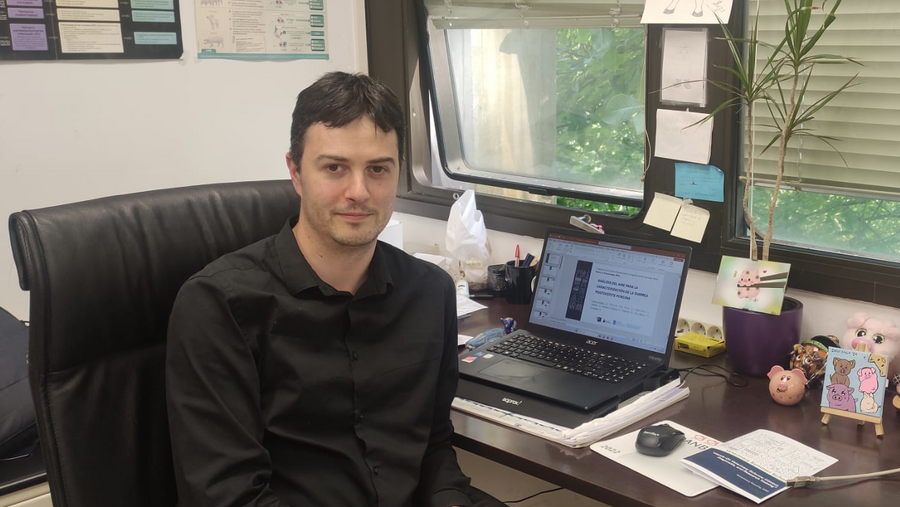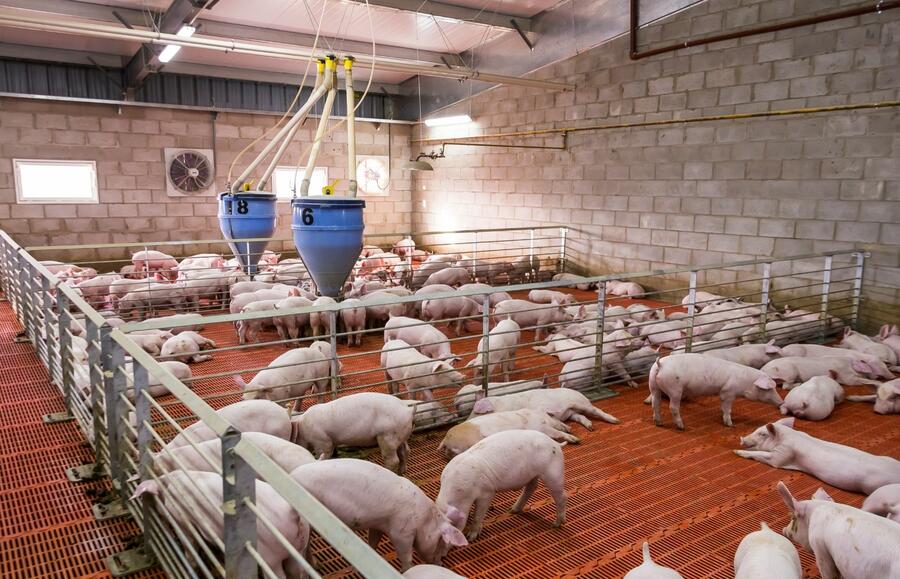Gonzalo López: «The main measure of animal welfare is freedom from disease»

Animal health is, and must be, one of the fundamental pillars on which a society capable of meeting the needs of the present without neglecting those of future generations is based.
This concept, which is becoming increasingly important on the global stage, brings together essential concepts such as food safety, economic sustainability, human health, and animal welfare.
That is why the work carried out on a daily basis by researchers such as Gonzalo López Lorenzo, who specializes in the study and control of infectious diseases affecting farm animals, is so necessary.
A postdoctoral researcher and lecturer in the Department of Animal Pathology at Campus Terra, we interviewed Gonzalo López to learn about the relationship between animal health and welfare, the latest developments in pathogen detection without the need for animal handling, and how he applies his scientific findings to the world of teaching.
-What led you to specialize in animal health and, specifically, infectious diseases in pigs?
-Something that was always clear to me from the moment I started studying veterinary medicine was that I wanted to specialize in pigs. This is due to both a family tradition and a greater attraction to highly technical animal production, primarily pig and poultry farming.
As for infectious diseases, the reason is straightforward: they pose the primary challenge in this type of production, where veterinary medicine plays a crucial role in their control and prevention. This is essential to guarantee animal health, as well as public health, and, no less importantly, the economic viability linked to these animal productions and the rural environment in which they are located.
-One of the research projects you worked on focuses on the detection of pathogens in environmental samples. What advantages does this methodology offer over traditional diagnostic systems?
-The main advantage of this methodology is that an environmental sample represents a population of animals, not just one animal or group of animals. This means that the sensitivity for detecting an infection in the population can be higher than when sampling a representative number of animals.
This is directly related to the economic cost, as traditional systems often require a large number of samples to gather information about the population, thereby increasing the financial cost of sampling and laboratory analysis. This constraint is significantly reduced when using environmental samples.
Finally, we must highlight something that is no less important from a social perspective: animal welfare. The use of environmental samples eliminates the need for animal handling to assess the presence of pathogens on farms.
-In your studies on porcine circovirus type 2 (PCV2), you detected the virus in areas where there were no animals. What implications does this finding have for health control on farms?
-This finding is key to showing simply and visually the importance of the epidemiology of an infection in its control.
There is a big difference between treating diseases and fighting infections. For example, when treating a disease, measures focus on acting on the animals, either by treating the sick, using vaccines to prevent the disease, or implementing management measures aimed at reducing contact between sick and healthy animals, for instance.
On the other hand, when we want to develop a health control plan, i.e., combat an infection, we must go further and address more specific aspects that have an impact on the emergence of diseases. For example, we may have optimal measures in place to provide immunity to animals. Still, if they remain exposed to the agent that causes the disease, cases of that disease will appear sooner or later.
Suppose we know which viral or bacterial agents capable of causing disease may be present in areas of farms without animals. In that case, we will also be clear that this will have an impact on the maintenance of the infection on the farm and probably also on its transmission. Similarly, attention should be paid to these areas as critical health risk points, especially since they may be areas where personnel, due to their role, frequently come into contact with livestock.

-Air analysis as an epidemiological surveillance tool seems to be gaining relevance. What technical challenges does it involve, and how can it transform the control of diseases such as PRRS?
-Air analysis on farms presents an enormous technical challenge, as a pathogen causes each infection, each with its etiology (bacterial or viral), and within each type, there is an infinitely wide variety; therefore, its behavior in the air is not the same for all.
For this reason, a successful methodology for detecting one infectious agent in the air may be insufficient to detect another; therefore, refinement is needed to tailor it to each specific infection. One factor that makes PRRS challenging is that it is caused by a virus with a very low infectious dose, meaning that a very low concentration is capable of causing infection. This is also one of the challenges of detecting it in air samples: detecting these small quantities.
However, just as the technical challenge is very great, so can its application be if it is achieved. Regarding PRRS, the primary characteristic of the virus that causes this disease is its ability to mutate, which limits the protection provided by vaccines. For this reason, it is not enough to detect and monitor the presence of the virus on farms; it must also be sequenced to detect these mutations and limit their impact as much as possible.
In a hypothetical scenario where this low amount of PRRS virus is detected in the air on farms and sequenced from these types of samples, it would be possible to identify the different strains of the virus circulating on the farm. This measure could anticipate disease outbreaks and adapt control measures to reduce the incidence of these emerging strains. This would transform the control of this disease, as until now, it has only been possible to sequence samples from individual animals or groups of animals, detecting only the strain of the virus present in those animals.
-A study on post-weaning diarrhea in pigs is currently being finalized. What were the main results, and how could this work influence the reduction of antibiotic use in pig production?
-The main result I would highlight is the great capacity of farm air analysis to characterize the pathogens involved in post-weaning diarrhea.
Regardless of the farm's health status, we observed a strong correlation between air analysis and fecal swab analysis of piglets. However, it is insufficient as a surveillance measure to prevent outbreaks of diarrhea. I must say that I am not satisfied with this result. Still, it was to be expected, as post-weaning diarrhea is a disease influenced by a wide variety of factors at the farm level, which makes it very difficult to obtain conclusive results.
Considering the latter, I must say that the influence on antibiotic reduction is limited. However, I would like to add that, for the first time, we conducted a genotypic characterization of the bacterial resistance levels present in animals with diarrhea using air samples, yielding satisfactory results. Continuing this line of work could be useful for monitoring the evolution of antibiotic resistance and limiting its spread.
-From a teaching perspective, how do you integrate your lines of research into the practical training you provide to veterinary students at Campus Terra?
-The lines of research I work on are difficult to integrate into the practical classes I teach, mainly because, in some cases, they still need refinement before they can be directly applied to disease control or are restricted to very specific cases. Despite this, I emphasize the importance of obtaining disease diagnoses at the population level as we work with groups of animals in daily practice.
In the case of pig production, this has been essential for many years due to the large number of animals we work with and their relatively low individual value. However, the trend in all livestock production, and more evident in current dairy production, is towards farms with an increasing number of animals. This situation forces us to focus on infection control by increasingly considering the group as a whole.
-What practical skills do you consider essential for students to develop in the subjects of Infectious Diseases and Preventive Medicine?
-One skill I would highlight is the ability to integrate all the information they have, from the knowledge provided by theoretical and practical training to their critical ability to assess the situation on each farm. This is key to correctly diagnosing possible diseases, treating them, and developing control and prevention plans.
-Campus Terra focuses on specialization. How does this environment contribute to your daily research and teaching work?
-Without a doubt, the contact with researchers and teachers whose daily work is related to mine.
My main specialization is sustainable animal production and health, a subject that relates directly to me and establishes links for collaboration with colleagues in the areas of animal production but also allows me to create synergies with colleagues working in fields related to hygiene or production efficiency on farms.
-Finally, what challenges and opportunities do you see for animal health in the current context of antimicrobial reduction and biosecurity?
-The biggest challenge I would highlight is animal welfare, both for production animals and companion animals. The reduction of antimicrobials is a necessary measure to protect a fundamental goal: human public health. However, it undoubtedly has consequences for animal health, the most obvious being an increase in mortality.
That is why I mention animal welfare, as socially, these words seem to be associated only with more space per animal, the presence of toys, social interaction or collective housing. I must emphasize that the main measure of animal welfare is freedom from disease and, if necessary, appropriate treatment when and as soon as it is required. In the context of antimicrobial reduction, the latter is not always possible.
